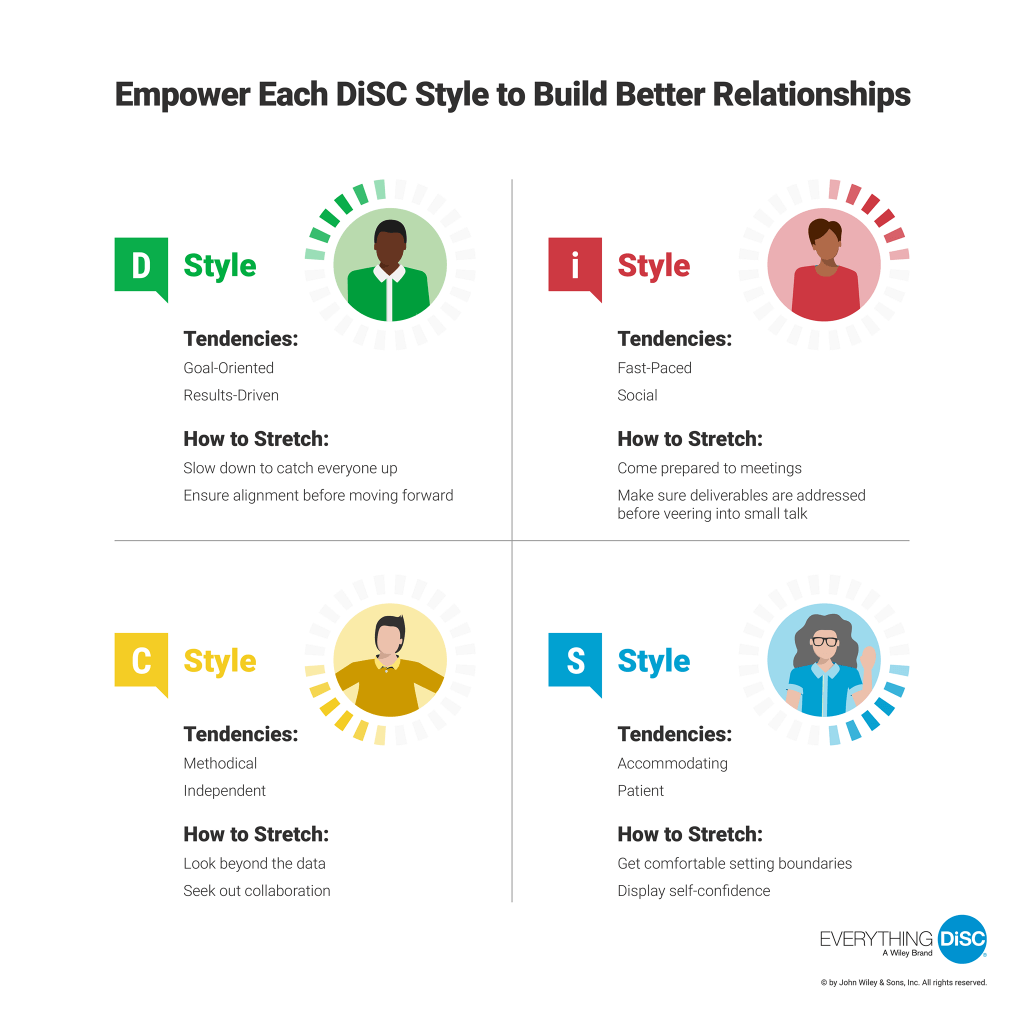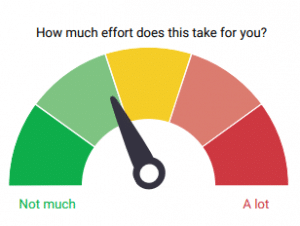Despite what you may have been told, the Golden Rule doesn’t always work. It’s often more important to do unto others as they prefer—not as you prefer. That’s why learning about other DiSC® styles and how to respond to them is so critical for effective communication. Relationships are improved when people can respond to not just their own needs, but also to the needs of others.
Let’s look at an example. You’re a manager with a new employee. Your former direct report, like you, was very sociable and direct. You even knew they were a Di style and that was very complimentary to your iD style. Neither of you gets upset if a conversation goes off-topic for a bit, and you’re intimately familiar with thinking out loud. Now you’re working with someone who is quiet, serious, and cautious. You’re not going to change your personality to match theirs, but you will be more successful if you flex into their style when giving them feedback or when trying to motivate them. Part of getting the most from your new hire will involve adjusting some of your own behaviors.
What is personality flexing?
Flexing or stretching in the context of DiSC simply means employing behaviors that don’t come as easily to you as other behaviors. You might do this to respond to the priorities of someone you’re selling a product or an idea to, or in order to get your point across most effectively. Sometimes it might feel like compromising, but it’s really about doing your best to understand and be understood.
The DiSC model is a great way of thinking about the continuity of behaviors and priorities. You don’t just get a set of letters to reflect your personality. Your complexity of personality is also depicted by a dot in a circle with shading that reflects how much your style reflects all the styles measured.
We can think of our own DiSC style or our dot placement as our familiar and comfortable home base. We can leave home. In other words, we know how to get to other style locations/behaviors, we just don’t choose to live in those neighborhoods. Someone with a C style might enjoy their time alone in their living room researching their favorite topic. That doesn’t mean they can’t also enjoy going to a party and dancing once in a while. They’ll just need to stretch and call on some behaviors they don’t exercise much.
Another way of explaining it is to use the metaphor of a rubber band. If your rubber band is pinned at your dot, it will be harder to stretch it all the way across the circle than to stretch a bit to one side. And your band will bounce back to your dot. If you keep stretching your band, it will get easier to move to any point in the circle.
Why flex into another style?
Flexing makes us more versatile. We do it all the time. You probably learned as a kid which tactics worked best to influence a parent or teacher. Maybe your English teacher responded well to high spirits and tolerated noise, but your science teacher did not. So you acted a little differently depending on which class you were in. Or, at least, you knew you should try. Flexing gives us more options.
Below you’ll see examples from Everything DiSC Agile EQ.
Benefits of stretching to an S style:
- Helps you keep an open mind
- Ensures you’re supportive and approachable
Benefits of stretching to a C style:
- Helps you separate facts from emotions
- Allows you to stay rational under pressure
Benefits of stretching to an i style:
- Helps you build trust and open channels of communication
- Fosters a sense of camaraderie and inclusion
Benefits of stretching to a D style:
- Conveys to others your conviction in your opinions
- Brings candor to situations that benefit from straight talk
When to flex
When you took the Everything DiSC® assessment, you might have thought to yourself something like “yes, I’m results-focused right now at work, but not at home.” Or maybe you thought, “I can be a good listener, but I’m not sure that I usually am.” This could mean that you’ve been flexing your style in response to a need or a person. We all flex, but the real benefit of doing so is knowing where, when, and how to do it.
We flex when we want to influence a decision, when we’re selling to a customer, when providing customer support, when supporting an elderly relative, or when responding to a toddler. We stretch into less familiar styles whenever we need to direct our energy to a behavior that meets the recipient’s needs more than our own.
Whenever you’re challenging yourself, you may be stretching into another style. A CD style taking a group dance class is probably stretching more than their muscles because they are doing something they don’t already have expertise in. An iD style learning new Excel functions by reading through help menus is probably stretching because they are doing something repetitive by themselves. And these types of challenges likely offer some rewards.
Example of flexing
Let’s look at an example. You’re reporting to your manager on a recent meeting. Knowing their iS style and returning to your Everything DiSC® Management report could really help you shape your account. You will want to keep these tips in mind:
i style: Focus on the new or the changing, suggest what might be next, show enthusiasm (if genuine), report on anything that will affect the team, include any interesting tidbits you learned, use adjectives. Answer the “who” questions: who was involved, who will take next steps, who will want to know.
S style: Focus on what was on the agenda, how decisions were made, how they and their people will be affected, be clear. Ask what else they want to know. Answer the “how” questions: how will this work, how will this affect others, how will we measure success.
You can review these quick tips and combine them with what else you know about your manager’s quirks and priorities to give them what they need. That’s much better for both of you than giving them the type of report you might have preferred. And, of course, your manager will also benefit by knowing how someone with your DiSC style generally prefers feedback and recognition.
When feeling overstretched
Repeated flexing can wear you out. So it’s important to know how to recharge yourself. If you’re a C style who will be presenting at a conference, you’ll probably want to skip the happy hour event afterward and go home to read a mystery. If you’re a D style and also the primary caregiver for a parent, you probably need to keep your regular tennis game schedule. We all need time off from flexing to recharge.
If your DiSC dot is farther from the style you need to flex into, you’ll need more energy to get there. Your battery will drain if you don’t find ways to recharge it. Knowing what behaviors give you energy is just as important as knowing which ones drain it.
We can watch for signs of overstretching. Have you noticed that most summaries of DiSC styles will include something about less-than-positive characteristics? For example, the DC style tends to overuse bluntness and can have a sarcastic or condescending attitude. They may be digging in their heels or “going it alone.” These behaviors can be a signal that the DC is getting overstretched. If you notice a colleague spending more time in the “overuses” part of their personality, it could be time to review their style’s fears and help them find ways to express their style in healthy ways.
It’s possible that some flexing might not be a choice you make, but rather something imposed upon you. The COVID-19 pandemic did this, limiting the social opportunities for the i and S styles. Thinking creatively about how to keep your own energy tank filled, and asking others with similar styles what they are doing, can be helpful.
In the context of DiSC, flexing one’s style is an option we have. It is a skill we can develop to better meet our own priorities and improve our relationships. It’s a confirmation of how we can choose how to communicate and behave. It’s also a rejection of using DiSC as an excuse for bad behavior.



